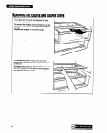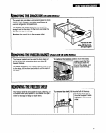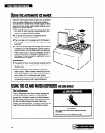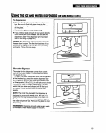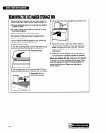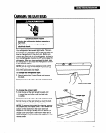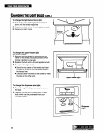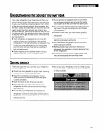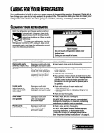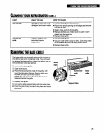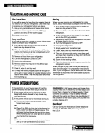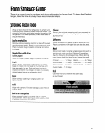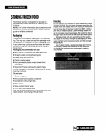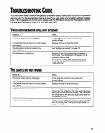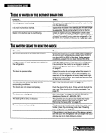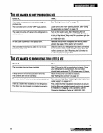
CARING FORYOUR REFRICERLTOR
Your refrigerator is built to give you many years of dependable service. However, there are a
few things you can do to help extend its product life. This section tells you how to clean your
refrigerator and what to do when going on vacation, moving, or
during a power outage.
Both the refrigerator and freezer sections defrost
E!!
automatically. However, clean both
about once a month to help prevent
odors from building up. Wipe up spills
right away.
To clean your refrigerator, turn the
Refrigerator Control to OFF, unplug it, take out all
removable parts, and clean the refrigerator accord-
ing to the following directions.
Bum Hazard
Do not touch refrigeration tubes near
defrost pan.
Doing so can result in burns.
PART
WHAT TO USE
HOW TO CLEAN
Removable parts
Sponge or cloth with mild 0 Hand wash, rinse, and dry thoroughly.
(shelves, crisper, etc.)
detergent and warm water
Outside
Sponge, cloth, or paper
towel with mild detergent,
warm water, and a good
appliance wax (or good
auto paste wax)
0 Wash outside of cabinet. Do not use abrasive or
harsh cleaners.
0 Wipe and dry thoroughly.
0 Wax painted, metal surfaces at least twice a year.
Apply wax with a clean, soft cloth. Waxing exterior
painted, metal surfaces helps provide rust
protection. Do not get wax on plastic parts
or gaskets.
Inside walls
(allow freezer to
warm up so cloth
won’t stick)
Sponge or soft cloth
0 Wash with mixture of warm water and:
with baking soda or mild
-mild detergent, or
detergent and warm water
- baking soda (2 tbs to 1 qt [about 25 g to 1 L]
of water).
0 Wipe and dry thoroughly.
Door liners
and gaskets
Sponge or soft cloth
with mild detergent
and warm water
0 Wash, wipe, and dry thoroughly.
DO NOT USE cleaning waxes, concentrated
detergents, bleaches, or cleaners containing
oetroleum on elastic Darts or aaskets.
Plastic parts
(covers and panels)
Sponge or soft cloth
with mild detergent
and warm water
0 Wash, wipe, and dry thoroughly.
DO NOT USE paper towels, window sprays,
scouring cleansers, or flammable fluids.
These can scratch or damage plastic parts.
See “Important Safety Instructions” on page 3.
24
WITH OUESTIONS OR COMMENTS



